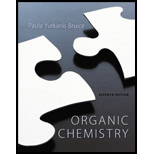
(a)
Interpretation:
The major product should be given, if
Concept introduction:
Aromaticity:
The
The organic molecule must planar, cyclic and conjugate and satisfy the
(b)
Interpretation:
The major product should be given, if the carbocation forms phenol by losing
Concept introduction:
Aromaticity:
The aromatic compounds are type of organic compounds, which has a special property’s in the reactivity and structure, they are,
The organic molecule must planar, cyclic and conjugate and satisfy the
Want to see the full answer?
Check out a sample textbook solution
Chapter 11 Solutions
Organic Chemistry; Modified MasteringChemistry with Pearson eText -- ValuePack Access Card; Study Guide and Student Solutions Manual for Organic Chemistry, Books a la Carte Edition (7th Edition)
- SO3H 69. Which of the following is not true of SN1 reactions? A. They are favored by nonpolar solvents. B. The concentration of nucleophiles does not affect the rate of reaction. C. Tertiary alkyl halides generally react through this mechanism. D. They occur through a 2-step concerted reaction. Refer to the reaction to answer the items 70 to 72. ОН CS₂ - Bra 70. What is the minor product formed from this reaction? A. o-bromophenol B. p-bromophenol C. m-bromophenol D. Both A and Barrow_forwardIn which of the following solvents would the reaction of 1- bromobutane with sodium azide, NaN3, proceed the fastest? a. acetic acid b. ethanol c. water d. acetonitrile a O barrow_forwardIdentify the reagents that will form the product in the reaction below. a. HBr O b. 1. Disiamylborane, 2. H202, NaOH O c. Cl2, H20 O d. H20, H2SO4, H9SO4 Oe. 1. BH3•THF , 2. H2O2, NaOH е.arrow_forward
- a. Identify the substitution products that form when 2-bromo-2-methylpropane is dissolved in a mixture of 80% ethanol and 20% water. b. Explain why the same products are obtained when 2-chloro-2-methylpropane is dissolved in a mixture of 80% ethanol and 20% water.arrow_forward43. Identify the reagent that will produce the following brominated product in greatest amount. Br A. Br₂/uv ? B. Br2/FeBr3 C. NBS D. Br2/CC14 44. Under acidic condition, which of the following compounds can not be oxidized by KMnO4. A. toluene B. 2-butene C. methylcyclohexane D. 2-butynearrow_forwardChoose the reagent(s) that would be most likely to complete this reaction. OH Q a A B C D E 1. OSO4 (catalytic) NMO Br2 H₂O 1. Hg(OAc) 2, H₂O 2. NaBH4, NaOH RCO3H 1. BH3-THF 2. H2O2, NaOHarrow_forward
- Choose the reagent(s) that would be most likely to complete this reaction. HO 1. Hg(OAc)2, H2O 2. NaBH4, NaOH Q Q 1. OsO4 (catalytic) A 2. NMO Br2 B H2O 1. BH 3-THF C 2. H2O2, NaOH 1. Hg(OAc)2, H₂O D 2. NaBH4, NaOH E RCO3Harrow_forwardWhich of the following starting materials and reagents would be best to produce a racemic mixture of 3-methyl-3-hexanol? a. heptanone and 1. CH3MgBr 2. H3O+ b. hexanal and 1. CH3MgBr, 2. H3O+ c. 3-hexanone and 1. CH3MgBr, 2. H3O+ d. butanal and 1. CH3CH2MgBr, 2. H3O+arrow_forwardHow does gold help to catalyze the reaction in the gold catalysis experiment? It deprotonates the methanol, making methanol a better nucleophile. оа. o b. It donates electron density to the alkyne, making the alkyne a better nucleophile. О с. It coordinates to the methanol, making methanol a better nucleophile. o d. It coordinates to the alkyne, making the alkyne a better electrophile.arrow_forward
- 5. In an organic reaction, which of the following is most likely to function as only a nucleophile? a. BF3 b. (CH3)2CH2NH2 с. Fe2+ d. CH3CH2S¯ e. both a and carrow_forward14. What is the best choice of reagent to perform the following transformation? Br A. HBr B. Br2, CH2C12 ragien C. H2,Pt D. Br2, H2Oarrow_forwardHCI is a byproduct of this reaction. Which statements are true? CH₂ . Cl₂ HCI prevents CH3 from acting as a leaving group HCI ensures that only one H of the CH3 is substituted by lowering the pH CH₂CI HCI can accelerate the reaction as it forms by catalyzing keto-enol tautomerism HCI can slow the reaction by enabling the formation of an enolate + HCIarrow_forward
 Organic Chemistry: A Guided InquiryChemistryISBN:9780618974122Author:Andrei StraumanisPublisher:Cengage Learning
Organic Chemistry: A Guided InquiryChemistryISBN:9780618974122Author:Andrei StraumanisPublisher:Cengage Learning
